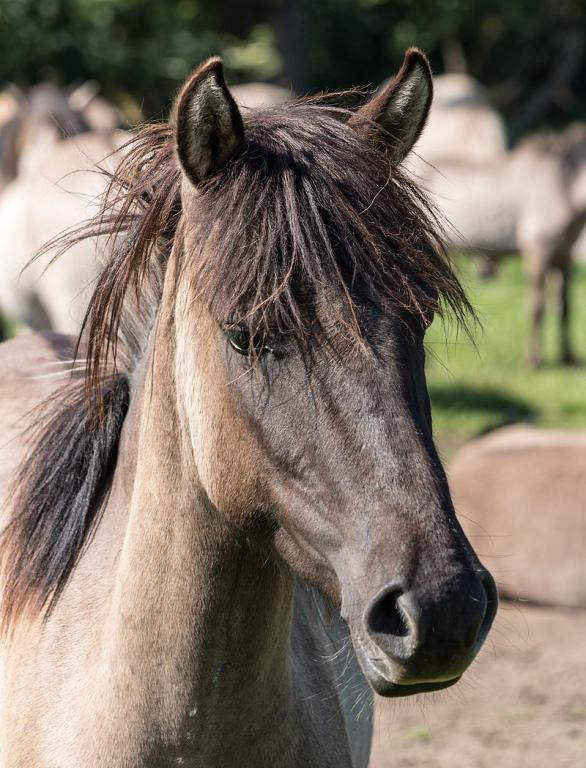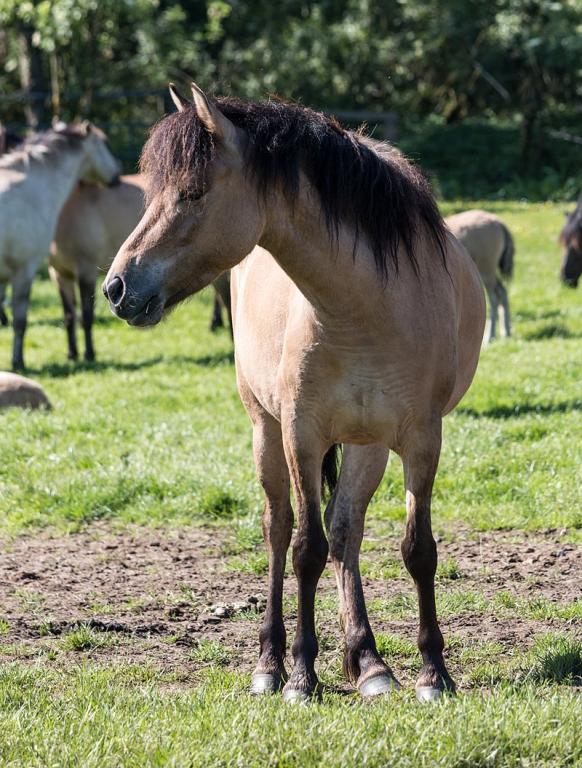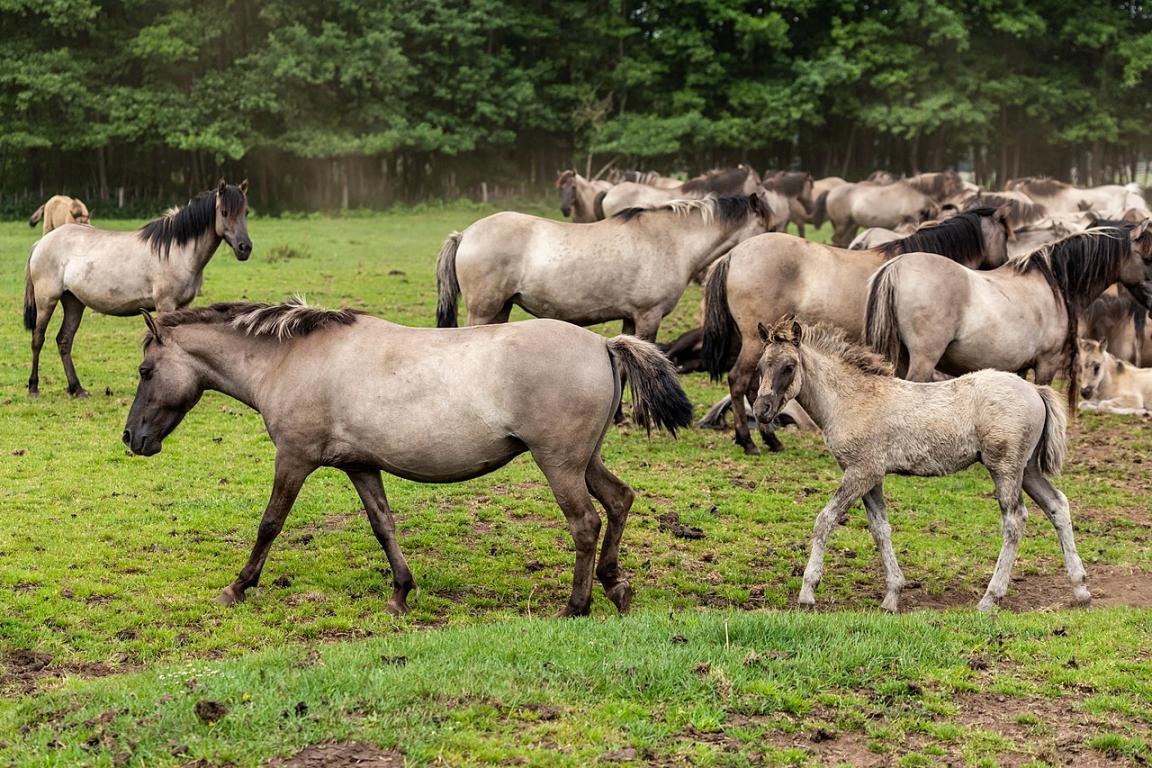
Continent: Europe
Country: Allemagne
Weight: 200 – 450 kg
Height: 125 – 135 cm


Originating from the Münsterland region in North Rhine-Westphalia (Germany), the Dülmener is considered the last remaining representative of Germany’s wild pony populations.
This breed developed naturally over centuries in the moorlands and wetlands surrounding the town of Dülmen, where small, hardy horses lived in semi-liberty. Historical records dating back to the 14th century confirm their presence, but it was in the 19th century that preservation became a local concern, with the establishment of the Merfelder Bruch nature reserve. There, a herd of Dülmener ponies still lives in an almost wild state, selected primarily for traits such as resilience, self-sufficiency in feeding, and stable social behavior within the herd.
Dülmener breeding is historically concentrated in northwestern Germany, primarily in the Münsterland region of North Rhine-Westphalia.
At the heart of this area lies the Merfelder Bruch nature reserve, near the town of Dülmen, where the last herd of semi-wild ponies still lives. Outside this reserve, a few private breeders and institutions in Germany continue to select Dülmener ponies for conservation or educational purposes. Although the breed remains rare outside of Germany, it is gaining growing interest among equine genetic conservation circles across Europe.
The Dülmener holds exceptional genetic value as a reservoir of primitive traits and hardiness, preserved through strict natural selection in semi-wild conditions. Its ability to survive without intensive human care, its resistance to disease, high fertility, and stable social behavior make it a valuable asset for conservation programs.
It represents a unique example of non-directed selection, offering a rare opportunity to study natural adaptation over generations. In equine genetics, it is also considered a living genetic heritage, useful for broadening the gene pool of modern breeds or reinforcing key traits such as robustness and frugality in other European ponies.
The Dülmener is one of the oldest pony breeds in Europe, with a history that stretches back several centuries across the plains of Münsterland, Germany. Documents from the 14th century already mention the presence of wild horses in this region.
As other free-roaming horse populations gradually disappeared, Duke Alfred von Croy took action in 1847 to protect the last remaining groups by establishing a dedicated reserve: the Merfelder Bruch, near the town of Dülmen. This marked a turning point—since then, the breed has been monitored and managed, though never truly domesticated. The ponies still live there today in semi-wild conditions, reproducing naturally, with only one annual human intervention: the "Rangieren", a spring roundup used to select young stallions. This tradition, combining management and cultural heritage, has allowed the breed to retain its primitive traits while ensuring its survival to this day.
The Dülmener is known for its calm, well-balanced, and highly sociable temperament, shaped by its life in a semi-wild herd. Raised without daily human contact, it develops a strong herd instinct, remarkable adaptability, and a high level of self-sufficiency.
Despite its free-roaming lifestyle, the Dülmener is generally curious, gentle, and unafraid, which makes it easy to tame when removed from the reserve for domestic use. Its mental resilience, intelligence, and lack of aggression make it an ideal partner for gentle training methods, animal-assisted therapy, or outdoor family activities, particularly with children. This stable and reliable behavior is one of the breed’s greatest assets.
The future of the Dülmener is closely tied to the challenges of biodiversity conservation and the preservation of equine genetic heritage. Thanks to its unique semi-wild lifestyle and a management approach that respects natural balance, the breed is attracting increasing attention from conservationists, researchers, and enthusiasts of ancient horse breeds.
Local and European initiatives are actively supporting the preservation of the Merfelder Bruch herd, while also developing parallel controlled breeding programs to safeguard genetic diversity. There is also a renewed interest in these ponies for educational, eco-grazing, and tourism purposes, where their hardiness, frugality, and strong herd instincts are highly valued. However, the limited number of breeding individuals remains a major challenge, requiring ongoing vigilance to prevent inbreeding and ensure long-term population stabilit
The Dülmener is an extremely hardy breed, with very few health issues, thanks to centuries of rigorous natural selection in semi-wild conditions. Living without regular veterinary care in the Merfelder Bruch reserve, only the most resilient individuals survive and reproduce, resulting in strong overall constitution and robust natural immunity. To date, no specific genetic predispositions or notable hereditary diseases have been documented in the breed. However, as with any genetically limited population, caution is needed to avoid the risks of inbreeding, especially among individuals raised outside the original herd. Rigorous genetic monitoring is therefore recommended for private breeding programs.
Slow, steady, and well-balanced gait. Suitable for covering long distances. The Dülmener maintains good balance even on difficult terrain.
The Dülmener shows a smooth and active trot with good impulsion despite its small size. The gait is natural, regular, and without exaggeration. Its movements reflect the breed's adaptation to rough terrain, showing good coordination and stable balance—typical of horses living in semi-wild conditions.
Short but energetic, often seen during escape or play within the herd. Its compact build allows for a controlled and efficient canter.